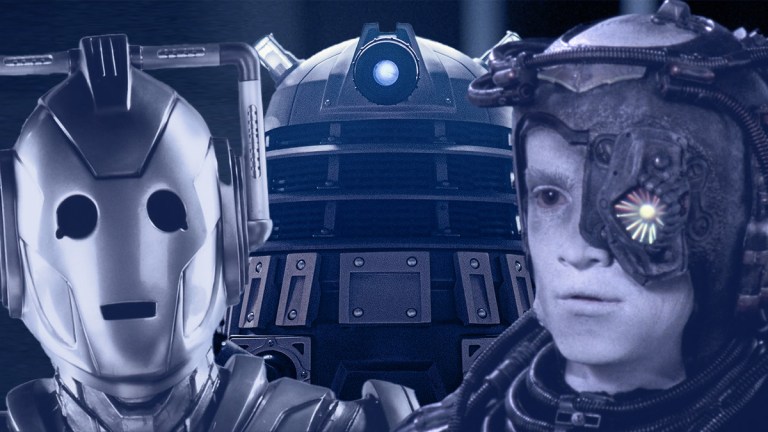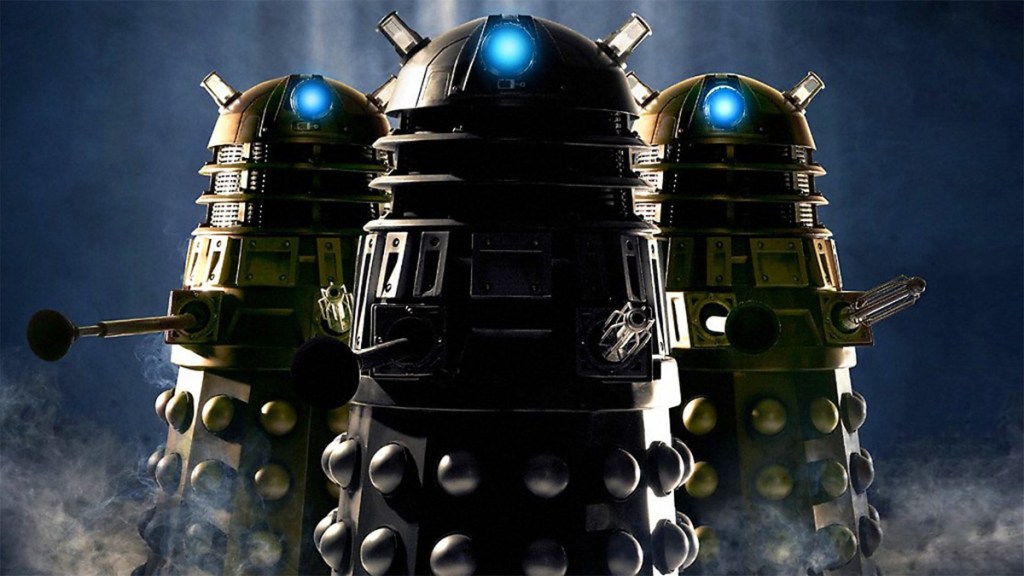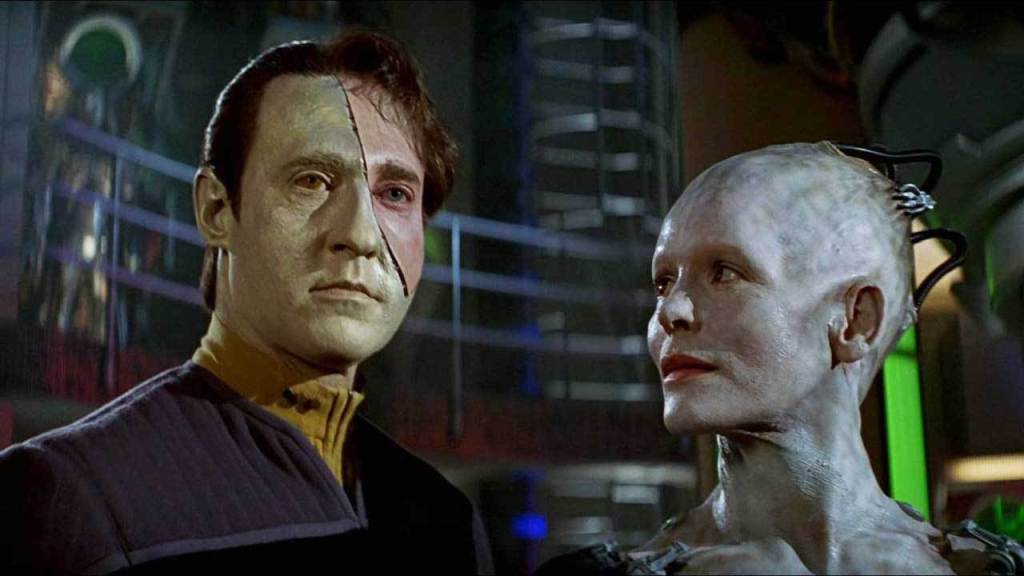Doctor Who vs Star Trek: Which Aliens are Better?
We like Doctor Who's aliens. We like Star Trek's aliens. But who's better? There's only one way to find out: FIGHT!

Why are we fascinated by science fiction? Is it the opportunity to extrapolate technological and sociological trends beyond our current experience? Is it the way it helps us to appreciate our place in a vast and unknowable universe? Is it the way that it gives us a fresh perspective from which to examine the human condition?
No! It’s none of those things. It’s aliens. Aliens are the number one best thing about science fiction, which is why we can objectively and correctly rank large science fiction franchises according to which one has the best aliens.
And out of those franchises, the biggest ones with the most detailed alien cultures are Doctor Who and Star Trek (Please go to the comments and argue about Star Wars vs Farscape among yourselves, and try not to pick on that one person fighting for Babylon 5).
To decide, again, objectively and correctly which aliens are better, we must look at a complex lattice of interrelated criteria, scientifically judging each one to objectively determine the best.
The Best-Looking Aliens?

This is, frankly, an easy win for the Doctor. Star Trek has a few standouts – the Horta, the Tholians, the Gorn, that Tardigrade on Discovery. But there is no getting around the fact that the vast majority of Star Trek’s alien life, across all four quadrants of the galaxy, are obviously human-looking guys with prosthetics glued to their heads. At best.
At worst – and there’s no getting around this – you have blackface.
Of course, Doctor Who has had its fair share of species that just so happened to evolve to look exactly like humans (the Doctor themselves is one), and there are plenty of species behind that which deviate from humanity only insofar as they genetically have more eyeliner.
But those are not the aliens for which Doctor Who is remembered. Doctor Who is remembered for creatures like the Zygons, evil-looking shapeshifters made entirely of tentacles, the massive rhinoceros faces of the Judoon, the fish vampires of “The Vampires of Venice”, the giant green clawed babies of the Raxicoricophallapatorians, Bo’s giant face, carnivorous shadows, and last but not least, the hideous mutated cycloptipus you’ll find behind the steering wheel of a Dalek.
These are creatures that look properly alien. The Doctor’s TARDIS may have a mysterious fascination for Earth (in particular the South of England and some bits of Wales), but the creatures that wash up there from the rest of the galaxy are fascinating to behold.
But we shouldn’t judge an alien by its carapace, so…
The Most Fascinating Contact Stories?

We go to stories of alien lifeforms not just because they look weird, but because they think weird. One of the very best alien stories of recent years was Arrival, with its temporally non-linear aliens that communicate exclusively through coffee cup stains. Some of the best writing of alien thought processes in recent memory comes from Adrian Tchaikovsky’s “Children of” trilogy. Even if most of the aliens are uplifted spiders, octopuses and ravens, Tchaikovsky does a great job of showing how minds other than humans might think, and at the same time show us that the human way of viewing the world is only one subjective perspective.
Star Trek does considerably better here. One of its most famous aliens is Spock, who (allegedly) has done away with emotion, giving us a perspective of pure logic (for a TV writer’s grasp of the word “logic”) that is often wildly different from his human crewmates, and yet just as valid.
Indeed, Spock formed something of a blueprint for Star Trek writers, and throughout the franchise, it has frequently reused the winning formula “Find an actor with perfect comic timing. Cast them as someone who doesn’t understand jokes”.
But beyond that, Star Trek gives us countless new perspectives. Years before Arrival, Benjamin Sisko was teaching the concept of linear time to the wormhole aliens, or the Binar, who work in hiveminds of two.
Yet while Star Trek undeniably has a wealth of cool ideas, its alien societies always seem to come in the same sort of shape. If you’re an alien civilization in Star Trek, there are good odds that you have warp drive and transporter beams, and shields something like phasers (you might call them disruptors for variety), and your ship-to-ship communication looks a lot like you’re calling them on Zoom. Even the ultra-alien species like the Borg pretty much fit this pattern.
Of course, there’s no denying that a lot of the Doctor’s interactions with aliens tend to follow a formula as well. While the Doctor visits a few alien planets, most aliens fall into one of two categories: An all-out invasion of planet Earth, or a clandestine invasion of the planet Earth.
But the actual methods and reason for the invasion vary wildly, as do the ways they interact with more humanoid characters. The Weeping Angels look like ordinary terrestrial statues, but the fact that they can only move when nobody is looking at them opens up all kinds of creative questions and implications. The Silence’s method of invasion by the power of being forgotten forces our heroes to come up with innovative ways to track them, as do the blind dream crabs that can only tell where you are if your eyes are open.
And the reason for that variety that all comes down to what these alien stories are actually about.
The Best Storytelling Subtext?

Can we blow your mind for a second? Believe it or not, a lot of science fiction actually has a metaphorical subtext. Sometimes even a political one.
In fact, if you don’t mind really having your mind blown, a lot of the stories in the original Star Trek series were actually a commentary on the Cold War (don’t worry if this shocks you, it was all extremely subtle).
That put a somewhat limited scope on how the Enterprise and her sister ships could interact with aliens. The Enterprise, after all, is a Starfleet ship on a military, diplomatic and scientific mission. It has orders and regulations and protocols and when it meets aliens it tends to be under specific circumstances.
You could meet diplomats for conferences (and by the way, is it weird that Starfleet’s most important flying conference centre was also its most devastatingly powerful battleship?), or you could meet up to rattle some sabres along an interstellar border, or you could beam down to an as-yet-uncontacted world and try really carefully not to do a colonialism.
The Doctor, meanwhile, is basically on a gap year, where the year is measured by the planet Neptune. The Doctor has no rules and will stumble, barge or be kidnapped and dragged into any number of situations. The aliens he encounters don’t represent nation-states, but everything from political ideologies, to childhood fears, to anxieties over technology, to weaponized playground games.
And admittedly, partly this is because Doctor Who dances around the fringes of what you might strictly call “science fiction”, into the territory of horror stories and fairytales. Its aliens are often not just “aliens”, they are monsters. Whereas Star Trek’s aliens, with a few exceptions, are intended to be our equals and opposites, Doctor Who’s aliens, when they aren’t outright invading, are lurking in the shadows or under our beds.
The Best Emotionless Cyborgs?

To see the contrast, we need to look no further than when both franchises hit upon the same idea (we will politely suggest that Star Trek arrived at the concept independently rather than outright nicking it). Cyborgs that remove all emotion and are connected via a hivemind. The Borg, and the Cybermen.
In both cases, there is never going to be more than the briefest of temporary peace treaties with these cyborgs (although Lower Decks does give us a glimpse of a future with Borg schoolchildren). In both cases, the cyborgs are a threat to our identity, our individuality, and use the threat of technology as a dehumanizing force.
Over time, both have evolved into, effectively, robo-vampires, force-infecting as many people as possible into becoming half-machine slaves with no identity. Often, irritatingly, they can be defeated with the old “destroy the head vampire” strategy, which defeats the entire point of a decentralized hive mind, but anyway, that’s another rant.
But also, both are ultimately less interesting versions of their original portrayal.
The Borg would have been so much more interesting if they had stuck to the portrayal seen in “Q Who?”, a society that grew cyborg babies in drawers and was only interested in assimilating technology after wiping off all those pesky organics. Originally, they would have been even more alien – with budgetary concerns eventually leading to the insectoid premise being watered down into more humanoid cyborgs.
The Cybermen, meanwhile, are far more interesting in their original incarnation – a society that had taken mechanical prosthetics to their logical conclusion, Ship-of-Theseusing themselves into the monsters they became to survive. When these Cybermen said they had removed all emotion, you believed them, and no Cyber-voice has yet topped the speak’n’spell stylings of the ones in “The Tenth Planet”, who sounds genuinely puzzled Earth’s humans don’t want to “be like us”.
Far from being utterly alien, the Cybermen came from another Earth. They were humanity’s potential future. And the Cycloptopus mutants inside the Daleks? Also started out looking exactly like humans. And the Toclafane from “The Sound of Drums” and “Last of the Time Lords”, and the Dregs from “Orphan 55”, and the Haemovores from “The Cure of Fenric” and the Futurekind from “Utopia” and seriously, you start to suspect the reason the Doctor is so protective of humanity is because they know that if we are left alone for five minutes we’ll just transform into genocidal monsters.
And before Trek starts getting all high and mighty about having actually alien aliens, it is worth pointing out that its own original show bible was based on the concept of “Parallel Worlds”, which is why the original run took us to the Nazi planet and the Gangster planet and the planet where the Roman Empire never fell and the planet that is exactly like Earth except all the grownups died and the children were immortal.
While we have been arguing about Doctor Who versus Star Trek, The Twilight Zone has snuck in with one of its trademark twists: the best aliens were humans all along.
